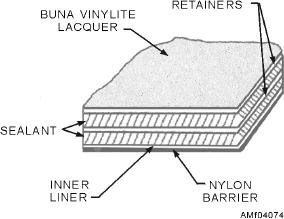
return to their original position. This mechanical
The combination bladder and self-sealing cell is
reaction is almost instantaneous.
made up of two parts. One part is a bladder-type cell,
and the other part is identical to the standard
The chemical reaction takes place as soon as fuel
construction cell. It is designed to self-seal holes or
vapors penetrate through the inner liner material and
damage in the bottom and the lower portions of the side
reach the sealant. The sealant, upon contact with fuel
areas. The bladder part of the cell (nonself-sealing) is
vapors, will extend or swell to several times its normal
usually restricted to the upper portion. This type of cell
size. This effectively closes the rupture and prevents the
is also semiflexible.
fuel from escaping. The sealant is made from natural
gum rubber.
SELF-SEALING CELL (STANDARD CON-
STRUCTION).--There are four primary layers of
The retainer material is the next material used in
materials used in the construction of a self-sealing cell.
fuel cell construction. The purpose of the retainer is to
These layers are the inner liner, nylon fuel barrier,
provide strength and support. It also increases the
sealant, and retainer. All self-sealing fuel cells now in
efficiency of the mechanical action by returning the
service contain these four primary layers of materials.
fuel cell to its original shape when punctured. It is made
If additional plies are used in the construction of the
of cotton or nylon cord fabric impregnated with Buna N
cell, they will be related to one of the primary plies.
rubber.
The inner liner material is the material used inside
SELF-SEALING CELL (NONSTANDARD
the cell. It is constructed of Buna N synthetic rubber. Its
CONSTRUCTION).--One variation from the
purpose is to contain the fuel and prevent it from
standard construction is the self-sealing fuel cell,
coming in contact with the sealant. This will prevent
shown in figure 4-74. It has four primary layers--an
premature swelling or deterioration of the sealant.
inner liner, a nylon fuel barrier, two sealant plies, and
three retainer plies.
Buna rubber is an artificial substitute for crude or
natural rubber. It is produced from butadiene and
The cords in the first retainer ply run lengthwise of
sodium, and is made in two types, Buna S and Buna N.
the cell. The cords in the second retainer run at a
The Buna S is the most common type of synthetic
45-degree angle to the first. The cords in the third
rubber. It is unsuitable for use as inner liner material in
retainer run at a 90-degree angle to the second. The
fuel cells. It causes the petroleum fuels used in aircraft
outside is coated with Buna-Vinylite lacquer to protect
to swell and eventually dissolve. The Buna N is not
the cell from spilled fuel and weathering.
affected by petroleum fuels, making it ideal for this
Baffles and internal bulkheads are used inside the
application. However, the Buna N is slightly porous,
cell to help retain the shape of the cell and prevent
making it necessary to use a nylon barrier to prevent the
sloshing of the fuel. They are constructed of square
fuel from contacting the sealant.
woven fabric impregnated with Buna N rubber.
The nylon fuel barrier is an unbroken film of nylon.
Flapper valves are fitted to some baffles to control
The purpose of the nylon fuel barrier is to prevent the
the direction of fuel flow between compartments or
fuel from diffusing farther into the cell. The nylon is
interconnecting cells. They are constructed of Micarta,
brushed, swabbed, or sprayed in three or four hot coats
Bakelite, or aluminum.
to the outer surface of the inner liner during
construction.
The sealant material is the next material used in
fuel cell construction. It remains dormant in the fuel
cell until the cell is ruptured or penetrated by a
projectile. It is the function of the sealant to seal the
ruptured area. This will keep the fuel from flowing
through to the exterior of the fuel cell (fig. 4-73.)
The mechanical reaction results because rubber,
both natural and synthetic, will "give" under the shock
of impact. This will limit damage to a small hole in the
fuel cell. The fuel cell materials will allow the projectile
to enter or leave the cell, and then the materials will
Figure 4-74.--Self-sealing fuel cell (standard construction).
4-47

